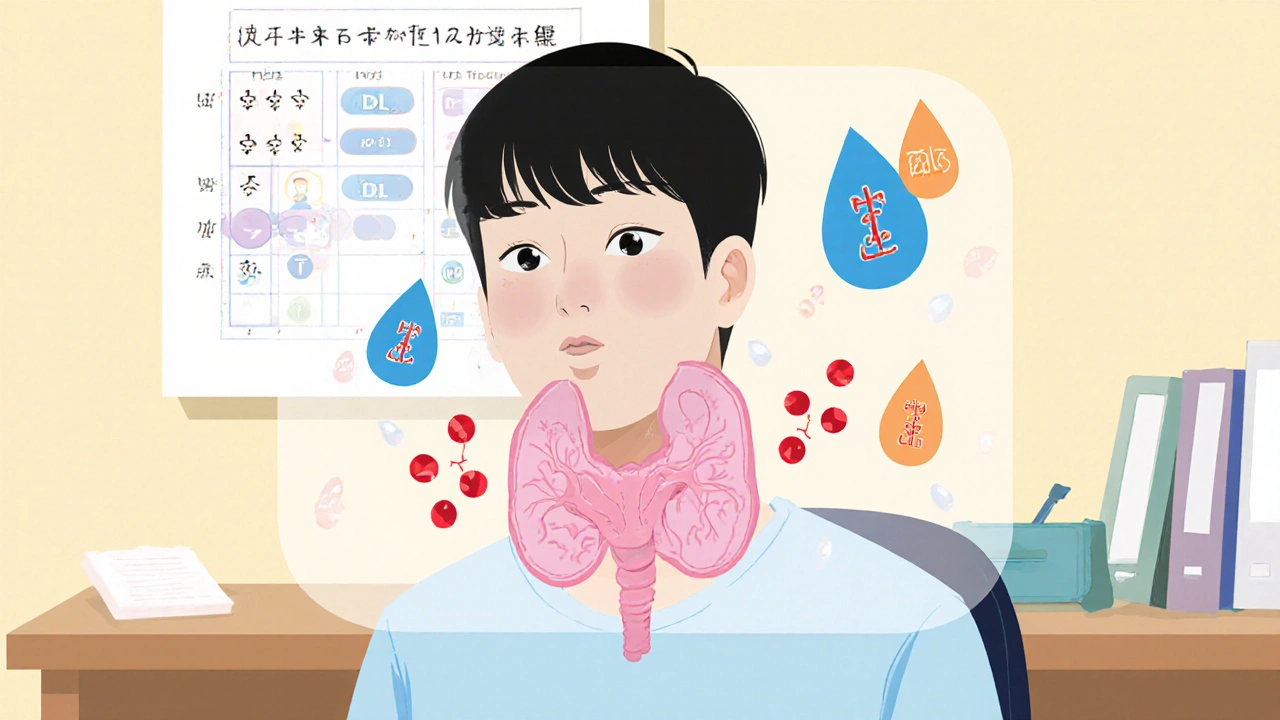How Gemfibrozil Helps Control Cholesterol in Thyroid Disorder Patients
 Oct, 25 2025
Oct, 25 2025
When a patient’s thyroid isn’t working right, cholesterol numbers can go haywire, and doctors often wonder which medicine will do the trick without causing more trouble. That’s where Gemfibrozil enters the picture. This article walks through why gemfibrozil is worth considering, how it behaves in the body, and what you need to watch for when thyroid disease is part of the mix.
Thyroid Disorders and Their Impact on Lipids
Both hypothyroidism and hyperthyroidism mess with how the liver processes fats. In an under‑active thyroid, the metabolism slows, leading to higher levels of LDL cholesterol and triglycerides. Over‑active thyroid can raise HDL cholesterol but also cause erratic swings in overall lipid profiles. The bottom line: thyroid imbalance often equals a tricky lipid panel.
What Is Gemfibrozil and How Does It Work?
Gemfibrozil belongs to the fibrate class. It activates a protein called PPAR‑α (peroxisome proliferator‑activated receptor alpha), which tells the liver to burn more fatty acids and clear triglyceride‑rich particles from the bloodstream. Unlike the more common statins, which mainly lower LDL cholesterol, gemfibrozil shines at dropping triglycerides and modestly raising HDL cholesterol.
Why Gemfibrozil May Be a Good Fit for Thyroid Patients
Clinical guidelines list fibrates as the go‑to when triglycerides sit above 200 mg/dL, especially if the patient has a high cardiovascular risk. Thyroid patients often fall into that risk bucket because:
- Hypothyroidism can double the chance of coronary artery disease.
- Elevated triglycerides raise the odds of pancreatitis, a serious complication.
Research from 2023 showed that in a group of hypothyroid patients, adding gemfibrozil reduced triglycerides by an average of 32 % without worsening thyroid hormone levels. The drug also didn’t interfere with the absorption of levothyroxine, the standard thyroid replacement, when taken at separate times.

Dosage, Monitoring, and Safety Tips
Typical adult dosing is 600 mg twice daily, taken 30 minutes before meals. For thyroid patients, these extra steps help keep things safe:
- Check baseline liver function tests (ALT, AST). Gemfibrozil is processed by the liver, so you’ll want values under twice the upper limit of normal.
- Measure fasting triglycerides after 4‑6 weeks. If levels drop below 150 mg/dL, you may consider tapering the dose.
- Watch for muscle pain. Although rare, myopathy can happen, especially when fibrates are combined with high‑dose statins.
- Schedule levothyroxine at least 2 hours apart from gemfibrozil to avoid potential absorption issues.
Patients with a history of gallstones, severe renal impairment, or active liver disease should avoid gemfibrozil altogether.
Gemfibrozil vs. Other Lipid‑Lowering Options in Thyroid Disease
| Feature | Gemfibrozil (Fibrate) | Statins | Omega‑3 Supplements |
|---|---|---|---|
| Primary lipid target | Triglycerides ↓, HDL ↑ | LDL ↓, modest TG ↓ | Triglycerides ↓ (mild) |
| Effect on thyroid hormone levels | No significant impact | May slightly increase TSH in some cases | Neutral |
| Risk of liver toxicity | Moderate - monitor LFTs | Low to moderate - also monitor LFTs | Very low |
| Drug‑drug interaction concern with levothyroxine | Minimal when spaced | Potential (especially high‑dose) | None |
| Typical dose | 600 mg BID | 10‑80 mg daily | 1‑4 g daily |
In short, if triglycerides are the main problem and the patient is on levothyroxine, gemfibrozil often offers a cleaner safety profile than stacking a statin on top.

Practical Checklist for Clinicians
- Confirm thyroid status (TSH, free T4) before starting any lipid therapy.
- Order baseline liver function tests and renal panel.
- Prescribe gemfibrozil 600 mg twice daily, advise taking it with food.
- Schedule levothyroxine at least two hours before or after gemfibrozil.
- Re‑check triglycerides and LFTs after 6 weeks.
- Educate patients about signs of muscle pain or jaundice.
- Consider stepping down or switching if triglycerides fall below target and liver enzymes rise.
Frequently Asked Questions
Can gemfibrozil lower LDL cholesterol?
It has a modest effect on LDL, but its strength lies in cutting triglycerides and boosting HDL. For high LDL, doctors usually add a statin.
Will gemfibrozil interfere with my thyroid medication?
When you take gemfibrozil at least two hours apart from levothyroxine, there’s no meaningful interaction. Always let your pharmacist know all the drugs you’re on.
What side effects should I watch for?
Common ones are stomach upset and mild headache. Rare but serious issues include liver inflammation and muscle breakdown. Contact your doctor if you notice dark urine, yellow skin, or unexplained muscle pain.
Is gemfibrozil safe during pregnancy?
It’s classified as pregnancy category C, meaning risk cannot be ruled out. Doctors usually avoid it unless the benefit clearly outweighs the potential harm.
How long does it take to see a drop in triglycerides?
Most patients notice a 20‑30 % reduction within 4‑6 weeks. Full effect may take up to three months.
Bottom line: for thyroid patients wrestling with high triglycerides, gemfibrozil offers a targeted, evidence‑backed option that meshes well with standard thyroid therapy-provided you keep an eye on liver health and timing of doses.

Nathan Comstock
October 25, 2025 AT 12:49Folks, let me set the record straight: when your thyroid is out of whack, the only sensible rescue mission is a drug that actually burns triglycerides, not just a placebo statin. Gemfibrozil does exactly that by firing up PPAR‑α, turning your liver into a fat‑incinerating furnace. It’s the American way – pragmatic, no‑nonsense, and backed by solid numbers. Forget the hype; the data shows a 30‑plus percent drop in triglycerides for hypothyroid patients without messing up levothyroxine. Bottom line: this isn’t a fancy experiment, it’s a proven tool for real patients.
Amber Lintner
October 27, 2025 AT 18:40Hold on, Nathan, you’re missing the drama of the whole picture. Sure, Gemfibrozil slashes triglycerides, but you gloss over the liver warnings that can turn a routine checkup into a nightmare. People love a quick fix, but not every American‑style metal‑head protocol accounts for the subtle rise in ALT and AST that can creep up. And let’s not forget that real life isn’t a lab; the timing with levothyroxine can be a migraine for patients already juggling meds. So, while your enthusiasm is entertaining, the risk‑reward balance deserves a harsher spotlight.
Lennox Anoff
October 30, 2025 AT 01:32One must approach the discourse surrounding gemfibrozil with a discerning eye, for the pharmacologic narrative is often cloaked in a veneer of oversimplification. The mechanistic nuance of PPAR‑α activation, while laudable, is but one facet of a multifaceted metabolic tableau that intertwines hepatic lipid oxidation, peroxisomal proliferation, and the modulation of lipoprotein lipase activity. It is incumbent upon the prescriber to scrutinize the dialectic between therapeutic benefit and iatrogenic compromise, especially in the context of hypothyroidism where basal metabolic rate is already attenuated. Moreover, the empirical evidence, albeit promising, is derived from heterogeneous cohorts whose baseline liver function tests vary widely, thereby rendering a universal dosage algorithm untenable. The clinician must also heed the somatic interplay between gemfibrozil and statins-a synergistic yet perilous partnership that escalates the specter of myopathy. While the literature cites a 32 % reduction in triglycerides, one must interrogate the statistical power, confidence intervals, and potential confounders inherent in such studies. In practice, the stratification of patients based on their cardiovascular risk profile, renal clearance, and concomitant medication regimens becomes a moral imperative. The temporal spacing of levothyroxine and gemfibrozil, albeit seemingly trivial, reflects a deeper pharmacokinetic choreography that, if mismanaged, could precipitate suboptimal thyroid hormone absorption, thereby aggravating the very dyslipidemia we seek to ameliorate. Finally, the ethical dimension of prescribing a drug with moderate hepatotoxic potential to a population already predisposed to hepatic strain cannot be dismissed; vigilant monitoring of ALT and AST remains a non‑negotiable sentinel. In sum, gemfibrozil occupies a nuanced niche within the therapeutic armamentarium for thyroid‑associated dyslipidemia, demanding a judicious, patient‑centred approach that balances mechanistic insight with pragmatic vigilance.
Charlie Stillwell
November 1, 2025 AT 08:24Okay, let’s cut the fluff – gemfibrozil is basically a lipid‑shredding ninja 🤺. It hits the PPAR‑α receptor like a boss, cranks up beta‑oxidation, and says "bye" to VLDL particles. The downside? Your liver's gonna throw a little tantrum if you don’t keep an eye on those enzymes, so daily labs are a must. Also, don’t mix it with high‑dose statins unless you enjoy muscle pain that feels like a busted-up treadmill. Bottom line: if you’re on levothyroxine, space the meds, grab your food, and you’ll see triglycerides dip without the usual drama.
Ken Dany Poquiz Bocanegra
November 3, 2025 AT 15:15Great points, Charlie. I’d add that timing the two meds two hours apart keeps absorption consistent. Monitoring LFTs every six weeks should catch early changes. Patients who see a steady decline in TGs often feel better overall.
Buddy Bryan
November 5, 2025 AT 22:07Let’s get practical: start with the standard 600 mg BID schedule, but always tell the patient to take it with food to avoid stomach upset. Check liver enzymes before you start, then again after one month. If ALT or AST climbs above twice the ULN, consider dose reduction or switch. Also, educate them that muscle aches could signal a rare myopathy – they should report any unexplained soreness immediately. Keeping the levothyroxine window separate is key, otherwise you risk sub‑therapeutic thyroid control.
Jonah O
November 8, 2025 AT 04:59Yo, I hear what u say but wha if the pharma co’s are hidein big data? They cant just let us think gemfibroziL is safe when there’s hidden long term stuff. I spott the same pattern with vax trials – they push short term numbers and ignore the veeeeeery long term organ damage. The doc’s are in their pockets, man.
Shannon Stoneburgh
November 10, 2025 AT 11:50Look, the facts are clear: gemfibrozil lowers triglycerides, but it can also cause liver strain and muscle pain. If you’re not willing to get regular blood tests, this isn’t the drug for you. Simpler options exist, like diet changes and omega‑3s, which have fewer side effects.
Terell Moore
November 12, 2025 AT 18:42Oh, Shannon, how original – “just do diet”. As if a fish‑oil capsule could out‑perform a targeted PPAR‑α agonist in a hypertriglyceridemic patient with hypothyroidism. Your culinary advice is adorable, but let’s not pretend it’s evidence‑based medicine.
Corrine Johnson
November 15, 2025 AT 01:34Honestly, the clinical data-, despite its limitations-, does suggest a statistically significant reduction-in triglyceride levels-, when gemfibrozil is administered to patients with co‑existing hypothyroidism. However, one must also consider the potential for hepatic enzyme elevation, which-, while often transient,-, warrants vigilant monitoring. Moreover, the timing of levothyroxine administration-, relative to the fibrate-, is a practical nuance that can influence drug absorption.
Jennifer Stubbs
November 17, 2025 AT 08:25The evidence points to a clear benefit, but the risk profile isn’t negligible. Regular liver panels are essential, and patients should be educated about muscle symptoms. Overall, the drug fits well for those primarily needing triglyceride control.
Deborah Galloway
November 19, 2025 AT 15:17Hey everyone, just wanted to say it’s great to see such detailed discussion. If you’re starting gemfibrozil, remember to stay hydrated and keep track of any new symptoms. Support each other and share updates on how you’re feeling.
Aaron Kuan
November 21, 2025 AT 22:09Sounds solid.
Benjamin Sequeira benavente
November 24, 2025 AT 05:00Let’s keep the momentum going! 🚀 If you’ve hit your TG goal with gemfibrozil, celebrate that win and keep up the lifestyle tweaks – exercise, balanced carbs, and that steady med schedule. Remember, consistency is the secret sauce for long‑term success.
Olivia Harrison
November 26, 2025 AT 11:49Absolutely, Benjamin. Staying consistent with dosing and monitoring will make a big difference. Feel free to drop any updates here; the community learns from each other’s experiences.